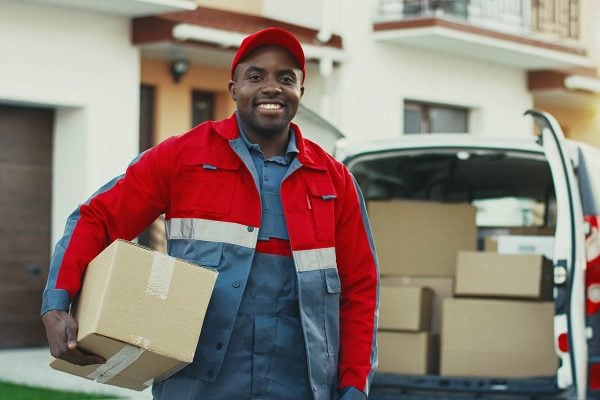 You’ll always find Matthew Robertson, Co-CEO of NetDespatch, at TDC Global and this year was no exception. It’s not only a great place to network with fellow colleagues in the delivery industry but a great opportunity to review the past year, especially the all important Q4 with Black Friday and Christmas, and to hear what challenges retailers faced and what innovations carriers will be introducing over the course of the next year.
You’ll always find Matthew Robertson, Co-CEO of NetDespatch, at TDC Global and this year was no exception. It’s not only a great place to network with fellow colleagues in the delivery industry but a great opportunity to review the past year, especially the all important Q4 with Black Friday and Christmas, and to hear what challenges retailers faced and what innovations carriers will be introducing over the course of the next year.
Matthew today shares how the delivery race is picking up the pace again and discusses not only how and why there’s an ever increasing drive to faster deliveries but what’s driving the need for speed.
Faster? Smarter? Better? – the delivery race picks up the pace again
There’s no shortage of innovation in the delivery industry and, with the number of parcels despatched annually estimated at around 1.5 billion, there’s clearly demand for faster, smarter, better ways in which to receive the goods we order. Next day delivery is now commonplace and, at the recent TDC Global (The Delivery Conference), there was a buzz around the prospects for same-day and even two-hour delivery. That got me thinking about how this will become a reality and looking at some of the innovations that aim to get our parcels to us faster than ever. Interestingly, some of the most potentially successful are less about delivery technology – drones, robots etc – and more about evolving delivery options to fit more intelligently into customer’s lives.
Speed sells
There’s no question that speed continues to be the key factor on which retailers compete and customer expectations rise with every new, faster option offered. According to IMRG research, more than 50% of parcels were ordered for next day delivery in 2018 – a total of 580 million altogether – and when that option isn’t available, sales suffer. It was sobering to hear of Holland and Barrett’s recent experience when the combination of problems with their online payment mechanism coincided with a conveyor belt breakdown at their distribution centre. Removing the next day delivery option to reduce pressure on the warehouse proved to have a negative effect on sales and post-event analysis showed that most first-time purchasers select the next day option so, by removing it, Holland and Barrett lost valuable new customers.
This kind of insight has a big upside, though, as it tells retailers about the behaviours and preferences of different customer demographics. This is knowledge that can be put to good use by identifying customer “tribes.”
Identifying customer tribes
By identifying “tribes” in which all the members have similar demands, retailers can offer a delivery service to match them. A case on point here is ASOS, which has recently launched an extension to its same-day service, ASOS Instant, targeted at students in Leeds.
The student tribe comprises spontaneous purchasers who prize instant gratification. They appreciate the ability to place an order in the morning and be wearing their new clothes the same evening. And, crucially, they all have links to a central location – the university campus – from where they can pick up their purchases after 5pm on the day of order. This means deliveries that would have spanned the city can be consolidated into a single drop-off, resulting in a win for ASOS and for Leeds University’s fashion-conscious students.
Identifying tribes who share behaviours and locations offers great potential to reduce delivery costs and traffic congestion. The vast quantities of customer data available to retailers should make this very achievable. How about targeting the nation’s commuters with pick-up points at stations, for example? This idea has received a major boost just this week with the Mayor of London and Transport for London launching a tender to bid for space to set up click & collect points in stations.
Last Mile
The last mile continues to be the most costly and difficult to cover on the journey between warehouse and customer. As our cities grow more congested and environmental concerns rise up the agenda there are plenty of ideas that bid to solve the conundrum of how to get that parcel into the customer’s hands. Drones and robots have long been the proposed solution to the problem but, despite advances, we haven’t quite managed to cut the human factor out of the last mile loop to date.
One initiative that neatly combines humans and technology was recently launched by Ford and GNewt. Dubbed the “warehouse-on-wheels” the service uses a zero-emissions electric vehicle and Ford’s cloud-based multimodal routing and logistics software to identify a location central to multiple parcel delivery points. The vehicle parks there, and is met by couriers on foot or bike, who unload the parcels and undertake the last stretch of the journey.
The warehouse on wheels could even be turned into a mobile click & collect point, broadcasting its location and inviting purchasers to travel a short way to collect their parcel.
Improving delivery success rates
On that subject, I believe click & collect is set to play an increasing role in improving delivery success and that’s reflected in its rising popularity. The fact is that people don’t want to sit at home all day waiting for their parcels and that naturally results in missed deliveries, which are frustrating and costly for everyone. IMRG’s Valuing Home Delivery report found that the cost of failed deliveries was £1.6billion in 2018. Click and collect, on the other hand, has an almost 100% success rate, because the control is placed in the hands of the customer who can decide when they want to pick up their item.
Similarly parcel lockers are seeing a resurgence in interest, with Hermes recently permitting customers to use its parcel lockers for delivery pick-ups. The Mayor of London’s congestion reduction strategy also includes a push to locate more parcel lockers around the capital’s transport infrastructure.
Smarter delivery gains ground
So, while speed remains the panacea, delivery is becoming smarter, too. By examining customer data and behaviours more closely and tailoring services to fit in with customers’ day-to-day lives, we can unite parcel and purchaser in a more intelligent, environmentally friendly and reliable way.










